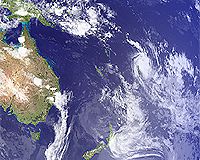| . |  |
. |
Port Vila (AFP) Oct 8, 2009 Huge earthquakes and a wide-ranging tsunami alert sent panicked Pacific islanders fleeing for the hills on Thursday fearing a repeat of deadly waves that smashed villages and killed 184 last week. Thousands evacuated from coastal areas, emptying schools and offices and jamming roads as shallow 7.8, 7.7 and 7.3 quakes struck in quick succession off Vanuatu, followed by a 7.0 tremor hours later and a series of aftershocks. "People are hysterical, trying to find out what's going on and contacting family members. Phone lines are going down as a result," an official with aid group CARE Australia said in the Vanuatu capital Port Vila. Similar chaos played out across the Pacific as authorities in the remote islands of Fiji, Tuvalu, New Caledonia hurried residents and tourists to higher ground. Samoa relived the terror of last week's freak tsunami strike, which wiped out entire villages and resorts, as frightened residents caused gridlock in the capital, Apia. Homeless survivors dropped rebuilding work and fled their makeshift hill camps to run higher up the slopes after hearing of the new warning. "Everyone was running up the mountains, they ran further than the settlements, you could see the panic and fear was still fresh from what happened," said journalist Tipi Autagavaia. "People didn't care about the distance or the elevation -- they just ran." The Pacific Tsunami Warning Center issued a warning for 25 nations and territories over much of the South Pacific, and stretching as far as Indonesia, Australia and New Zealand. However no damage was reported with a surge just 60 centimetres (two feet) seen in Port Vila. The tsunami warning was later cancelled. "The largest tsunami wave we have observed was in Port Vila and that was 60 centimetres from trough to peak," Stuart Weinstein, the warning centre's assistant director, told Radio New Zealand. "The Port Vila tsunami never got above the high tide mark which is good because that means it's unlikely to cause any destruction." The drama unfolded just eight days after the Samoa, American Samoa and Tonga tsunami and the catastrophic Sumatra earthquake, which is feared to have left thousands dead. Earlier on Thursday, the Philippines was hit by a 6.7 quake. But experts said the events were probably not linked despite coming unusually close together in the "Pacific Ring of Fire", a hotspot for seismic activity including the 2004 Asian tsunami that killed 220,000. "The Sumatra earthquakes are too far from the South West Pacific and more probably related to the 2004 earthquake to the north," said Kevin McCue, director of the Australian Seismological Centre. In Vanuatu, the tremors scattered residents and tourists from offices and beaches as word spread of the possible giant waves. "Our staff have told us that even tourists on the Pacific Dawn cruise ship docked in Port Vila heard people shouting that there was a big wave," said CARE Australia chief Julia Newton-Howes. In Fiji, police and troops stopped people entering the city centre, while officials ordered hotels to take tourists inland. New Caledonia officials sounded warning sirens and ordered people away from the coast on the main island and eastern Loyalty Islands, while the low-lying atoll nation of Tuvalu also hurried residents away from the shores. "We are trying to get those people staying closer to the coast to move inland," said Tuvalu's acting police commissioner Titelu Kauani. New Zealand was put on "tsunami watch" while Australia said it would be protected from any big waves by the enormous Great Barrier Reef. Share This Article With Planet Earth
Related Links Bringing Order To A World Of Disasters When the Earth Quakes A world of storm and tempest
 Pacific islanders flee as huge quakes prompt tsunami alert
Pacific islanders flee as huge quakes prompt tsunami alertPort Vila (AFP) Oct 8, 2009 Two powerful earthquakes triggered a tsunami alert over a huge swathe of the South Pacific Thursday, sending residents fleeing to higher ground, just days after giant waves killed 177 in the region. Vanuatu, Fiji, Tuvalu and New Caledonia sounded sirens and evacuated coastal areas after a 7.8 quake struck off Vanuatu at 9:03 am (2203 GMT), followed by a 7.1 tremor 10 minutes later, the US ... read more |
|
| The content herein, unless otherwise known to be public domain, are Copyright 1995-2009 - SpaceDaily. AFP and UPI Wire Stories are copyright Agence France-Presse and United Press International. ESA Portal Reports are copyright European Space Agency. All NASA sourced material is public domain. Additional copyrights may apply in whole or part to other bona fide parties. Advertising does not imply endorsement,agreement or approval of any opinions, statements or information provided by SpaceDaily on any Web page published or hosted by SpaceDaily. Privacy Statement |